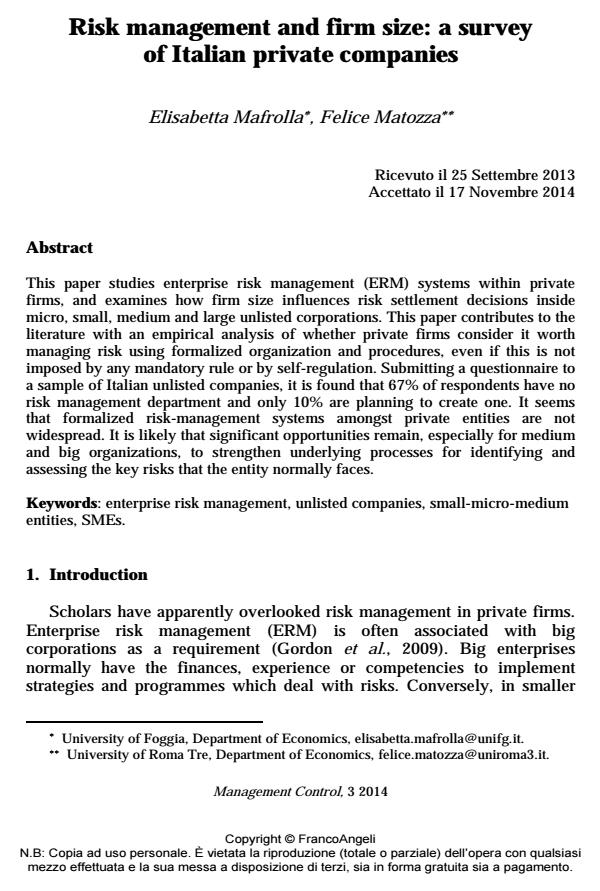Risk management and firm size: a survey of Italian private companies
Journal title MANAGEMENT CONTROL
Author/s Elisabetta Mafrolla, Felice Matozza
Publishing Year 2015 Issue 2014/3
Language Italian Pages 22 P. 87-108 File size 136 KB
DOI 10.3280/MACO2014-003005
DOI is like a bar code for intellectual property: to have more infomation
click here
Below, you can see the article first page
If you want to buy this article in PDF format, you can do it, following the instructions to buy download credits

FrancoAngeli is member of Publishers International Linking Association, Inc (PILA), a not-for-profit association which run the CrossRef service enabling links to and from online scholarly content.
This paper studies enterprise risk management (ERM) systems within private firms, and examines how firm size influences risk settlement decisions inside micro, small, medium and large unlisted corporations. This paper contributes to the literature with an empirical analysis of whether private firms consider it worth managing risk using formalized organization and procedures, even if this is not imposed by any mandatory rule or by self-regulation. Submitting a questionnaire to a sample of Italian unlisted companies, it is found that 67% of respondents have no risk management department and only 10% are planning to create one. It seems that formalized risk-management systems amongst private entities are not widespread. It is likely that significant opportunities remain, especially for medium and big organizations, to strengthen underlying processes for identifying and assessing the key risks that the entity normally faces.
Keywords: Enterprise risk management, unlisted companies, small-micro-medium entities, SMEs.
- Cause e implicazioni del cambiamento del revisore Silvia Ferramosca, Giulio Greco, in MANAGEMENT CONTROL 3/2015 pp.93
DOI: 10.3280/MACO2015-003006 - The national culture as a determinant of ERM quality: Empirical evidence in the European banking context Alessandra Allini, Raffaela Casciello, Marco Maffei, Martina Prisco, in MANAGEMENT CONTROL 1/2022 pp.79
DOI: 10.3280/MACO2022-001006 - Esiste una strategia di Internal Auditing che crea valore? Un'analisi empirica del contesto italiano Giuseppe D'Onza, Alessandra Rigolini, Francesco Brotini, in MANAGEMENT CONTROL 1/2016 pp.125
DOI: 10.3280/MACO2016-001008 - La valutazione del CdA in contesti ad elevata concentrazione proprietaria: mero conformismo o reale strumento di valutazione? Romilda Mazzotta, Giovanni Bronzetti, Graziella Sicoli, Paolo Tenuta, in MANAGEMENT CONTROL 2/2018 pp.107
DOI: 10.3280/MACO2018-002006
Elisabetta Mafrolla, Felice Matozza, Risk management and firm size: a survey of Italian private companies in "MANAGEMENT CONTROL" 3/2014, pp 87-108, DOI: 10.3280/MACO2014-003005